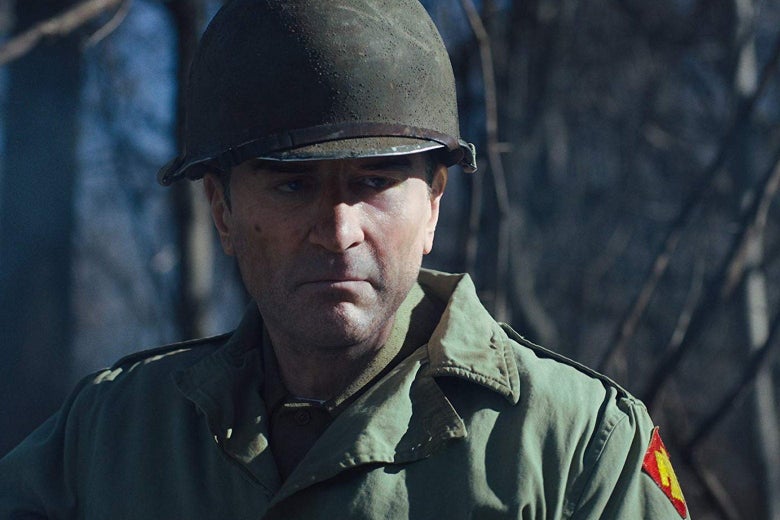
A digitally de-aged Robert De Niro in The Irishman.
Netflix
Before The Irishman’s world premiere at the New York Film Festival on Friday, the curiosity around the long-awaited new movie centered less around its stars (Robert De Niro, Al Pacino, and Joe Pesci) or its director (Martin Scorsese) than on the process of digitally de-aging its leads for the early parts of its story. Though the movie opens on its protagonist, hitman Frank Sheeran (De Niro) in old age sometime around the turn of the 21st century, it soon flashes back all the way to the 1940s, with De Niro, Pesci, and others playing the same characters over as much as 60 years.
The uncanny valley starts at the neckline.
One of the reasons it took so long to make the mob biopic was the technical and financial challenge of using digital effects to de-age the characters, which Scorsese admitted was something of a “costly experiment.” (Netflix stepped in to foot the reported $160 million bill.) The technology, the same Medusa rig used to return Samuel L. Jackson to his 1990s glory in Captain Marvel, improved during that period, but it also became more necessary as the cast continued to age. The last time anyone saw Jimmy Hoffa alive, he was 62; Pacino, who plays him, is 79. Scorsese, cinematographer Rodrigo Prieto, and the team from Industrial Light & Magic don’t push the technology to its limits the way the Marvel movies have, which means that during a World War II flashback that puts him in his 20s, Sheeran doesn’t have the smeary, soft-focus look of Robert Downey Jr. in Captain America: Civil War. The film smooths out De Niro’s wrinkles, but it doesn’t try to return his face to its youthful slimness, which creates the strange effect of a character who is believable as a young Frank Sheeran but not as a young Robert De Niro. The transformation isn’t seamless, but it’s less distracting than turning De Niro’s brown eyes blue, or the scraggly, pushed-forward hairline on Pacino’s Hoffa (which, to be fair, looks a lot like the real thing).
The real issue is not with the actors’ faces but with the rest of them: their voices and their bodies. At the press conference following the film, Scorsese talked about shooting a scene where Hoffa is watching TV with his family and gets up off the couch. They shot a few takes and felt ready to move on, but the ILM technicians pulled Scorsese aside to remind him that Hoffa is meant to be 49 in the scene, and Pacino wasn’t springing to his feet like a 49-year-old. (The next take, they quipped, Pacino got it down to 62.) The actors often sport boxy suits, presumably to camouflage their less-than-youthful frames, but something still feels subtly off. The one time the effects threw me out of the movie was the scene where a younger Sheeran meets with an associate in a sauna, and I had to wonder whose bare chest De Niro’s head had been stuck on. The uncanny valley starts at the neckline.
Get Slate Culture in Your Inbox
The best of movies, TV, books, music, and more, delivered three times a week.
The saving grace, if you choose to see it as such, is that The Irishman is the story of an old man looking back on his life, not a young man experiencing it for the first time. It’s a movie about how mortality hangs over us all—sometimes literally, as the film introduces new characters with text indicating the time and (usually violent) manner of their future death. Sheeran’s assassinations are treated matter-of-factly, as mundane as the euphemism in the title of the (ostensibly) nonfiction book it’s based on, I Hear You Paint Houses. There’s no adrenaline rush to the murders, no scenes luxuriating in the good times of mobbed-up life. The characters are never young and carefree, and they don’t deserve to be. Their outsides may have been digitally scrubbed clean, but the rot inside has been there from the beginning.
from Slate Magazine https://ift.tt/2npgarX
via IFTTT
沒有留言:
張貼留言